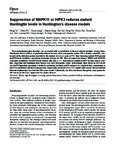Suppression of MAPK11 or HIPK3 reduces mutant Huntingtin levels in Huntington's disease models
| dc.contributor.author | Yu, M | |
| dc.contributor.author | Fu, Y | |
| dc.contributor.author | Liang, Y | |
| dc.contributor.author | Song, H | |
| dc.contributor.author | Yao, Y | |
| dc.contributor.author | Wu, P | |
| dc.contributor.author | Yao, Y | |
| dc.contributor.author | Pan, Y | |
| dc.contributor.author | Wen, X | |
| dc.contributor.author | Ma, L | |
| dc.contributor.author | Hexige, S | |
| dc.contributor.author | Ding, Y | |
| dc.contributor.author | Luo, Shouqing | |
| dc.contributor.author | Lu, B | |
| dc.date.accessioned | 2018-03-20T09:13:03Z | |
| dc.date.available | 2018-03-20T09:13:03Z | |
| dc.date.issued | 2017-12 | |
| dc.identifier.issn | 1001-0602 | |
| dc.identifier.issn | 1748-7838 | |
| dc.identifier.uri | http://hdl.handle.net/10026.1/11108 | |
| dc.description.abstract |
Most neurodegenerative disorders are associated with accumulation of disease-relevant proteins. Among them, Huntington disease (HD) is of particular interest because of its monogenetic nature. HD is mainly caused by cytotoxicity of the defective protein encoded by the mutant Huntingtin gene (HTT). Thus, lowering mutant HTT protein (mHTT) levels would be a promising treatment strategy for HD. Here we report two kinases HIPK3 and MAPK11 as positive modulators of mHTT levels both in cells and in vivo. Both kinases regulate mHTT via their kinase activities, suggesting that inhibiting these kinases may have therapeutic values. Interestingly, their effects on HTT levels are mHTT-dependent, providing a feedback mechanism in which mHTT enhances its own level thus contributing to mHTT accumulation and disease progression. Importantly, knockout of MAPK11 significantly rescues disease-relevant behavioral phenotypes in a knockin HD mouse model. Collectively, our data reveal new therapeutic entry points for HD and target-discovery approaches for similar diseases. | |
| dc.format.extent | 1441-1465 | |
| dc.format.medium | Print-Electronic | |
| dc.language | en | |
| dc.language.iso | eng | |
| dc.publisher | Springer Science and Business Media LLC | |
| dc.subject | PolyQ | |
| dc.subject | high-throughput screening | |
| dc.subject | protein homeostasis | |
| dc.subject | kinase | |
| dc.subject | positive feedback mechanism | |
| dc.subject | neurodegenerative disorders | |
| dc.title | Suppression of MAPK11 or HIPK3 reduces mutant Huntingtin levels in Huntington's disease models | |
| dc.type | journal-article | |
| dc.type | Journal Article | |
| plymouth.author-url | https://www.webofscience.com/api/gateway?GWVersion=2&SrcApp=PARTNER_APP&SrcAuth=LinksAMR&KeyUT=WOS:000416728800007&DestLinkType=FullRecord&DestApp=ALL_WOS&UsrCustomerID=11bb513d99f797142bcfeffcc58ea008 | |
| plymouth.issue | 12 | |
| plymouth.volume | 27 | |
| plymouth.publication-status | Published | |
| plymouth.journal | Cell Research | |
| dc.identifier.doi | 10.1038/cr.2017.113 | |
| plymouth.organisational-group | /Plymouth | |
| plymouth.organisational-group | /Plymouth/Faculty of Health | |
| plymouth.organisational-group | /Plymouth/Faculty of Health/Peninsula Medical School | |
| plymouth.organisational-group | /Plymouth/REF 2021 Researchers by UoA | |
| plymouth.organisational-group | /Plymouth/REF 2021 Researchers by UoA/UoA01 Clinical Medicine | |
| plymouth.organisational-group | /Plymouth/Research Groups | |
| plymouth.organisational-group | /Plymouth/Research Groups/Institute of Translational and Stratified Medicine (ITSMED) | |
| plymouth.organisational-group | /Plymouth/Research Groups/Institute of Translational and Stratified Medicine (ITSMED)/CBR | |
| plymouth.organisational-group | /Plymouth/Users by role | |
| plymouth.organisational-group | /Plymouth/Users by role/Academics | |
| plymouth.organisational-group | /Plymouth/Users by role/Researchers in ResearchFish submission | |
| dc.publisher.place | England | |
| dcterms.dateAccepted | 2017-08-08 | |
| dc.identifier.eissn | 1748-7838 | |
| dc.rights.embargoperiod | Not known | |
| rioxxterms.versionofrecord | 10.1038/cr.2017.113 | |
| rioxxterms.licenseref.uri | http://www.rioxx.net/licenses/all-rights-reserved | |
| rioxxterms.licenseref.startdate | 2017-12 | |
| rioxxterms.type | Journal Article/Review | |
| plymouth.funder | Tackling autophagy and apoptosis for the potential therapy of Huntington's Disease::MRC |


